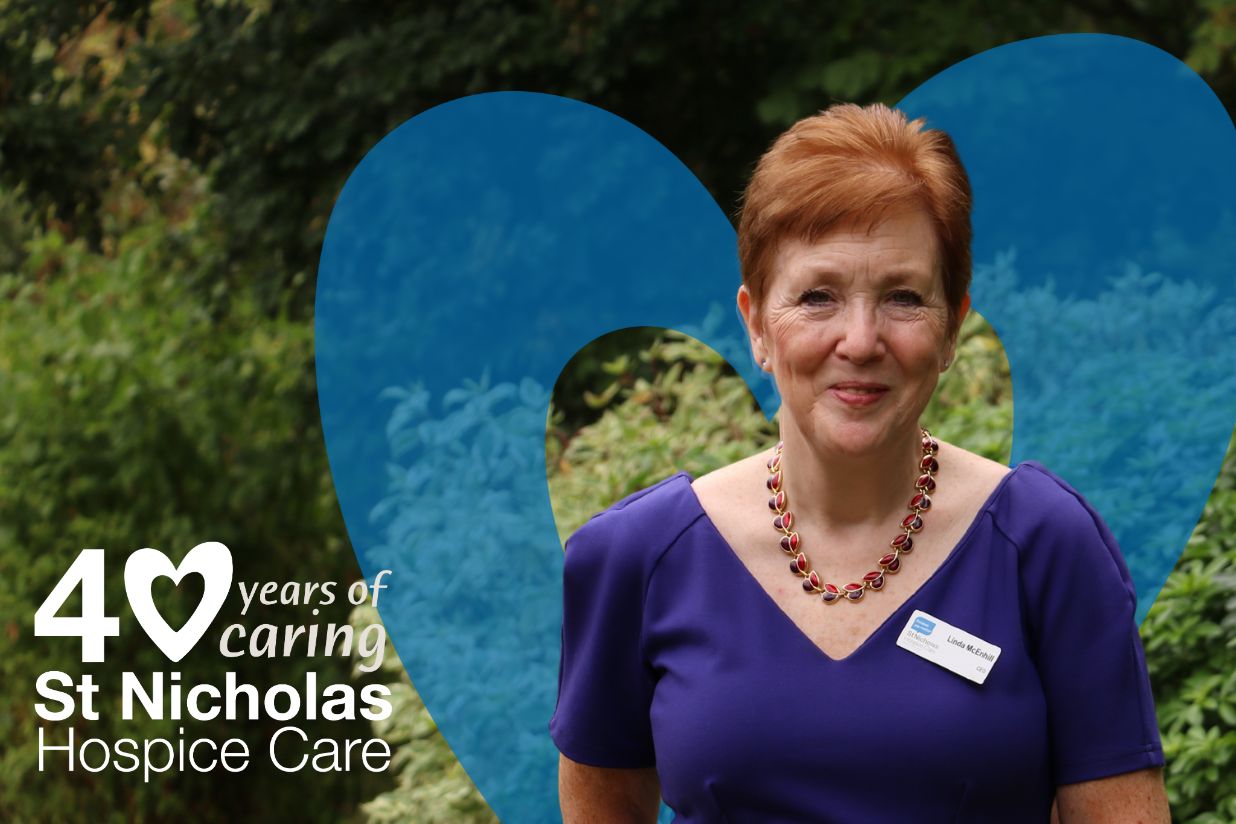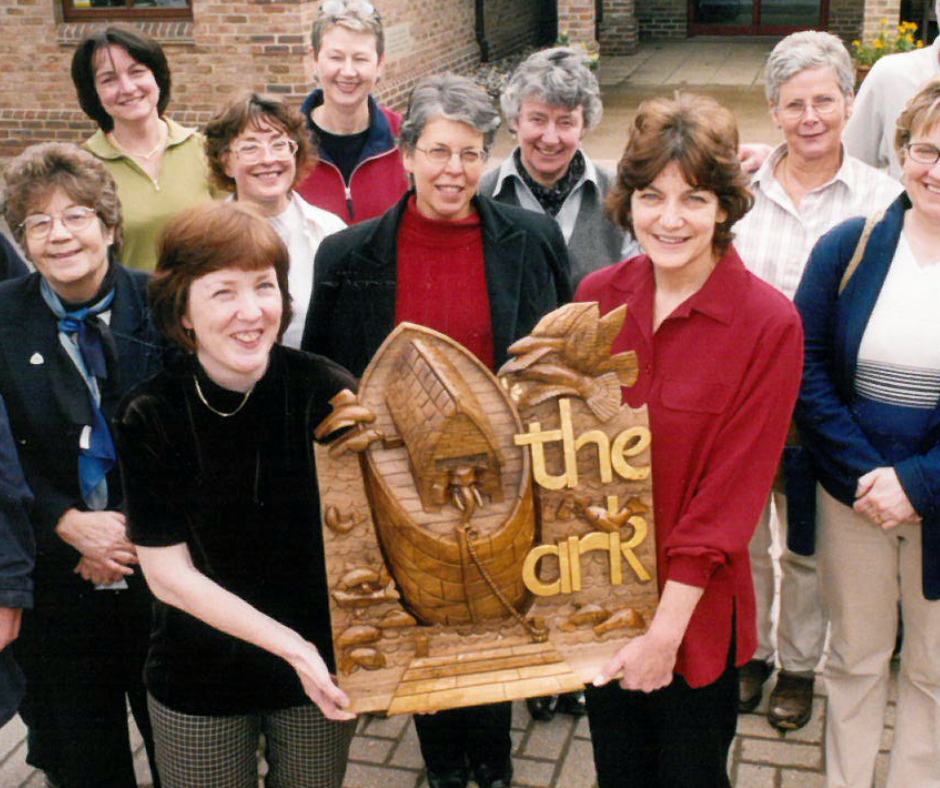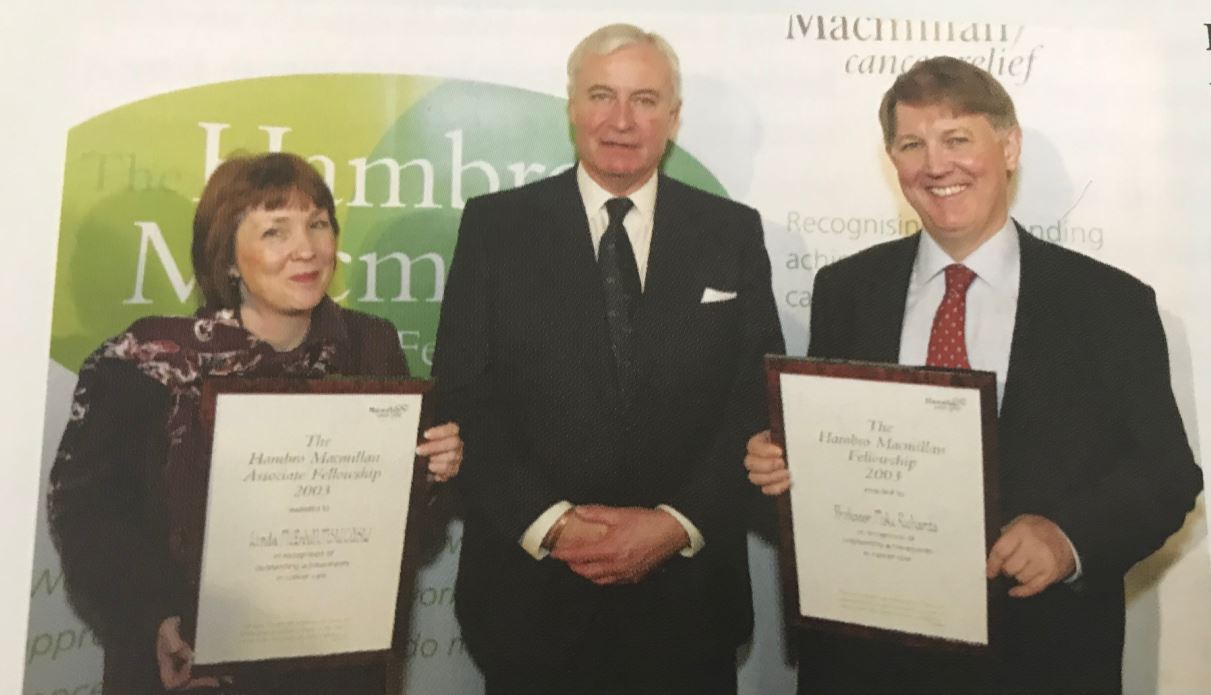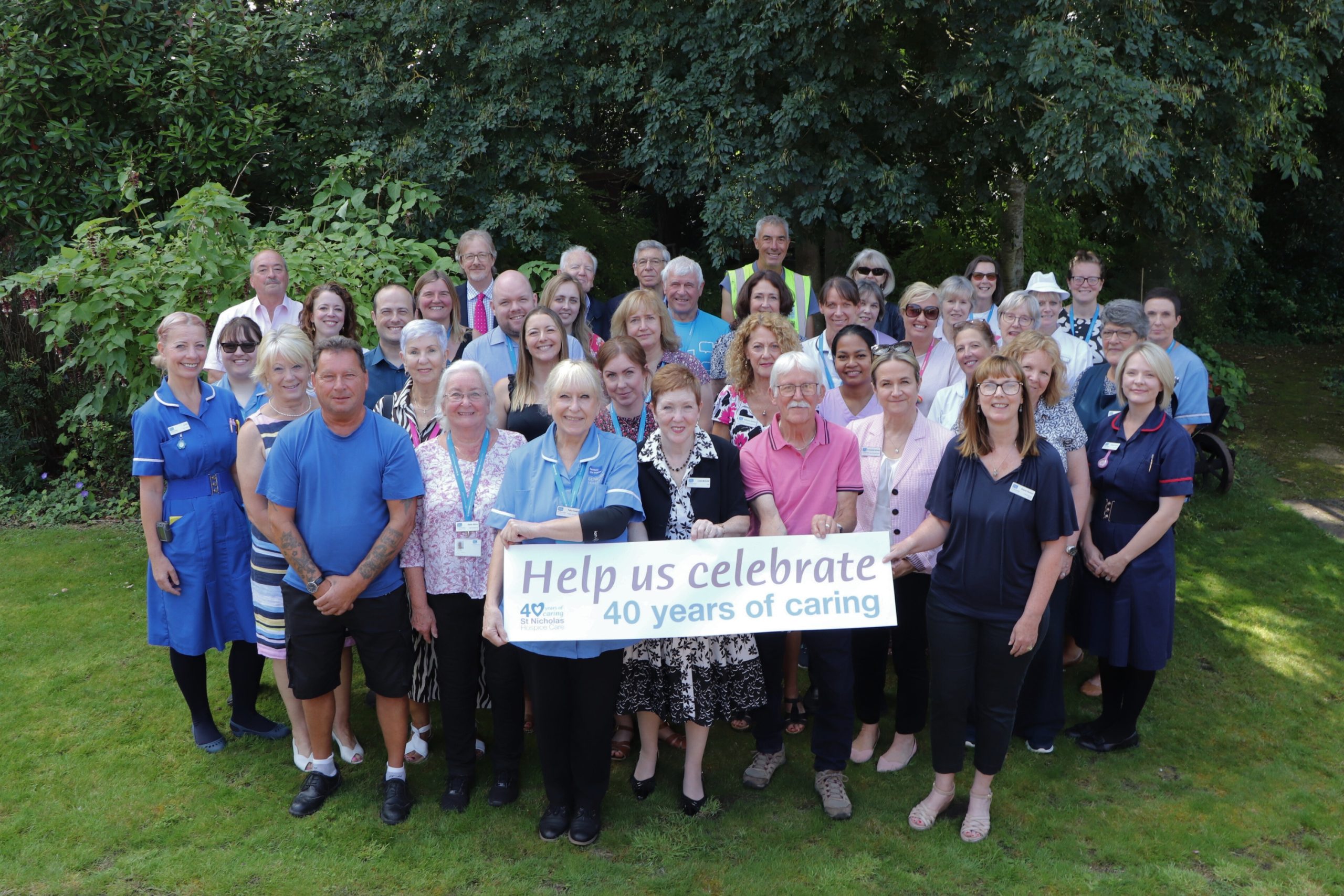Call our 24/7 advice line for health care professionals and families if you need support with symptom management and end of life care - 01284 766133.

Linda McEnhill, the Hospice’s Chief Executive Officer
Having officially started as St Nic’s Chief Executive Officer on December 13, 2021, Linda McEnhill was not a stranger to the charity, as a case of what some might call serendipity led her back through the doors for a second time.
An unusual beginning
Linda started her career in a Marie Curie Hospice in Glasgow as a principal social worker, and she says she had an unusual beginning as she was actually appointed to the post three months before she qualified as a social worker.
Having moved 85 miles from St Andrews to Glasgow once she arrived, she faced a rather large 44-bed hospice plus 10 sheltered houses and a large day service.
Linda recalls: “So it was a big job; I was brand new. I hadn’t even learned how to be a social worker in practice rather than in theory yet, and suddenly, there, I was responsible for all of family support, which was provided by, precisely, me. So, it was a very interesting way to begin my career.
“What I discovered from that job, and the reason I’m still in end-of-life care now 32 years later, is that it requires the use of every single part of yourself.
“So every part of your experience and your knowledge and your relationships, every part of your humanity is needed. And that’s very, very stimulating and engaging.
“I also learned that it (end-of-life care) was a place where I would meet ordinary people every day doing extraordinary things, finding deep within themselves the strength to face either their own death or somebody that they love dearly.
“I worked with parents who were leaving behind children. And although I found it incredibly hard, particularly after about my first six months when most of the people I’d engaged with closely began to die, I also absolutely fell in love with it.
“I worked with amazing people who taught me all sorts of things, taught me to review what it is to be a medic when you’re trained to cure, but actually, every day, your role is to help people who can’t be cured.”
I learned that there was a lot of fun and laughter and the importance of sticking in the moment. And I just fell in love with that as a way of working. Consequently, I've continued to do it in lots of different roles and lots of different ways. I've continued to work in end-of-life care because that just makes me feel I make a difference.
Arriving at St Nic’s for the first time
While working as a Macmillan counsellor for Charing Cross Hospital, Linda, who had spent some time as a loss and bereavement consultant in a learning disability trust, was at a conference when she was approached by the then head of Family Support at St Nic’s Mary Pennock.
Mary explained that she was considering retiring and asked if Linda would be interested in the role – and the rest, as they say, is history.
Linda explains: “Coming to St Nic’s was my first senior management role; it was closer to home, as I was working in London and living in Cambridge, but one of the things that really attracted me was that hospices are about multi-professional care and St Nic’s truly embraced that having both the Head of Family Support Services and the Chaplain on the senior management team.
When Linda took up her role Nicky’s Way, the Hospice’s bereavement service for children and young people had just been launched. A capital appeal had just raised £1m to enable the building of an area known as the Arc, specifically created to give space to the Family Support Team so they could work with adults and children coping with or facing grief.
Linda remembers: “I arrived at an interesting time. I was appointed in 2000 and came just at the very start of 2001.
“I came to a very established team who were quite dubious about me. One of them asked me the day I was interviewed, ‘How do you think you’re going to be able to manage us when you’re at least a decade younger than everybody in the team?’ So, I had to build my credibility.
“It was a great time; we built a team of 25 Nicky’s Way volunteers. There was a very established volunteer bereavement service. It turned out to be an absolutely fantastic opportunity to be here (working at the Hospice).”

I’m incredibly proud of what we did
When Linda arrived, our Nicky’s Way service was still in its infancy, since having gone on to be recognised with a Queen’s Award; when it first began, the service was unique. At that time, child bereavement services were not common, and hospices that did offer children’s pre and post-bereavement support only did so to those who had a connection with their patients. St Nic’s was different; we operated an open-access service, which meant we could help all children and young people coping with grief.
Linda recalls: “The thing that was different about St Nic’s right from the start was that the child bereavement service was completely community-focused. So we would look after children bereaved by suicide, murder, road traffic accidents, sudden deaths, and all the complexity around that.
“We also provided services for the parents of those children; we worked with them in a partnership so that together we would help their children to express their resilience. That was really uncommon at the time, and I’m incredibly proud of what we did under the leadership of some amazing children’s social workers.”
We were always committed to seeing bereavement as not something that means somebody's broken, to the idea that a child will have all the skills that it needs to be able to manage and navigate its bereavement so long as we don't get in the way. Most of our work was about helping children to express that inherent resilience.
Most of what I’ve done in my career since came as a result of what happened when I was here at St Nic’s
Linda’s desire for all people to have access to high-quality end-of-life care led her in 1998 to establish the National Network for Palliative Care of People with Learning Disabilities (pcpld.org).
This network, which raises awareness for the palliative care needs of people with learning disabilities and shares and promotes best practice, was recognised in 2003 when (while at St Nic’s) Linda was awarded the first Hambro Macmillan Associate Fellowship. Linda’s contribution to the development of the Network was recognised in 2008 when she stood down as founding chair, and an award was created in her name to recognise the contribution of individuals and organisations which have made a difference in the end-of-life or bereavement care of people with learning disabilities.
Linda says: “For me, personally, most of what I’ve done in my career since came as a result of what happened when I was here at St Nic’s. I was still relatively early in my career; I had a wonderful chief executive, Bob Jones. Bob was a very permissive and encouraging chief executive.
“So I could talk with him about aspirations and dreams, and Bob would normally say to me, ‘Oh, I know somebody that has some experience there; let me effect an introduction.'”
At the time she was leaving St Nic’s in 2005, partly because of the award, Linda came to the notice of Macmillan, who wanted her to set up what became the MacMillan and Network and Information Service. This virtual service was very innovative at the time as the internet and social media were less developed than they are now. The service was a national one that supported people with learning disabilities directly or organisations and people supporting them to better understand and navigate their way into hospice services.

The road looped its way back to St Nic’s
Happy in her role as Chief Executive at a Hospice in Scotland, Linda thought she would see out the rest of her career there quite content, but then, as she explains: “It was a strange set of serendipities by which I suddenly discovered that the post was vacant and a number of different things started a brainworm.”
With the support of her Husband (who would, at the start, face a 400-mile commute), family and friends, Linda began to think more about the role at St Nic’s and began the application process.
“Without my stint at St Nic’s (the first time), I wouldn’t have gone on to do all the other things that have prepared me to then be a chief executive.
“So, in a funny sort of way, both being here and leaving offered me huge opportunities. And after this length of time, having brought together the different strands, I felt perhaps I might have something to offer at this stage of the St Nic’s journey.”
So bizarrely, I found myself returning after 18 years of being away.
It’s an organisation that people love
Having left and returned some 18 years later, an obvious question for Linda is how much St Nic’s has changed. The Hospice has changed, services have had to adapt to various challenges, and some support has been discontinued. We still have our Sylvan Ward, Community Nursing Team and Psychological Services Team (then Family Support), but now we also have our Hospice Neighbours and Bereavement Cafes and will be looking to re-start some of our Hospice Day Services, which were paused during the pandemic.
Reflecting on the changes, she says: “It was a somewhat simpler organisation. As Head of Family Support, I sat in the senior management team, managed the Family Support Service, and carried a caseload for the first number of years.
“I came back to an organisation that had a much smaller directorate team, only three directors and a chief executive. Before, our senior management team was eight strong, with a chief executive.
“But actually, now we have another chunk, a different layer, which is our leadership team with a number of heads of service and then some managers under it. So it’s a more complex organisation.
“It was an organisation then that people loved; the community loved it, and that is just the same to this day. It was an organisation that, because it was very light on staffing numbers, people just had to be very flexible. I think there was only one person in the senior management team who wasn’t involved in delivering a service as well as taking a director’s role. That meant there had to be a lot of flexibility and that meant there had to be really good partnership relationships among staff.
“Which meant that we often had a lot of fun together as well. So, you know, it was a great organisation to be part of.”

Always manage with heart and head
If you look at job descriptions for a Hospice Chief Executive Officer quite often, the job summary will include something along the lines of:
• Assume overall responsibility and accountability for the operational leadership and management of the organisation, ensuring the effective, efficient and safe operation, meeting all clinical, statutory, financial, regulatory and legal requirements while delivering high-quality care and services to patients and families.
But what does that mean? When asked, Linda replied: “To be in a hospice, like any charity, is really challenging just now financially, regulation-wise, recruitment-wise. It’s very, very difficult. And you have to be able to, in those circumstances, in constrained funding, to always manage with heart and head. You need both of those things.
“In some ways, because my original training was as a social worker, that’s meat and drink to a social worker. You don’t have social workers in simple, straightforward, cosy situations. Social workers are only ever involved in the face of complexity of any number of types, and there’s always an element of loss and always against the backdrop of not enough resources. So, to some extent, even my very first training has been helpful to me.
“I’ve been lucky enough to do a Master’s Degree in Hospice leadership and worked with lots of other people to think through some of the challenges that we have.
“I have a single focus, which is to ensure the best end-of-life care for the people of West Suffolk and Thetford. Whenever I don’t know what to do, and there are days when I don’t, and whenever it’s hard to decide on which of the things that face you, the thing that you would rather do and the thing that you must do, then for me, I go back to first principles.
“The first principle for me is it is my job to ensure the best end-of-life care for the people of West Suffolk and Thetford. Period. So everything that I do is based on that. Now, that doesn’t mean that my assessment of what is the best thing in that situation is unerringly correct. Nobody’s infallible. But that’s the way you stay sane in a world where nothing’s perfect, and as a consequence, everything has to be thought about quite robustly
“The thing that’s wonderful about the role of Chief Exec is that, if you’re very fortunate, as we are here to have dedicated, compassionate staff who are innovative, they will find many, many, many more ways than I ever could to think about how we’re able to do this or that.”
The best bit of my job, without exception, is when I can hear somebody's idea, and I'm able to almost channel Bob Jones and say, 'That sounds fabulous. Yes, go ahead. Try and do that. Let's see how it goes.
We have reclaimed Canon Norburn’s vision
Before the pandemic, the Hospice was working to develop its Equip, Provide, Strive strategy. The ultimate aim and vision of this was that more people would be able to die in their own homes, in their own beds, surrounded by the things that give them comfort and the people they love. This would lead to less of a focus on Hospice beds.
Covid changed that: “It changed the world beyond recognition, and it introduced greater complexity and need, and at the same time, there is much more scarcity and fragility of services to meet that need,” said Linda.
Over the past two years, Linda, alongside the Hospice’s directors and trustees, has been developing a new strategy to meet our communities’ growing needs.
Linda explains: “We have reclaimed Canon Norburn’s vision. The dream for this Hospice grew out of his absolutely compelling vision that there had to be something better for people who are dying.
“Sadly, 40 years later, that need hasn’t gone away; in some places, it has gotten harder. It’s gotten harder because of the cost of living and the low funding levels for hospices. It has just become incredibly difficult, so we have spent a lot of time on developing our strategy, and we are now in the process of implementing that.
“Boiled down, what does it mean? What it means is that we continue to provide the best possible care for as many people as possible and continue to be embedded in our communities, working with and for our communities.
“Some 96 per cent of the last year of life for people is spent in their communities. We know that lots of the best parts of end of life care are not provided by us. They are provided by families and neighbours. The single biggest difference between being here previously and now is the need to collaborate, collaborate, collaborate.
“Where we are different now is that we are at the service of the whole health and social care system. We see ourselves as needing to be in partnership, so we are working really hard with the other two hospices in our ICS (Integrated Care System) area and our other partners.
“We are looking at ways we can work better to ensure there is less variation in care across the whole ICS area. We’re looking at whether we are the right organisation to provide something. If another organisation is providing something for our beneficiaries and they are doing it better, then we need not to duplicate it, we need to consider what the most strategic use of the limited resources we’ve got is and how to make sure that people have good end-of-life care no matter what setting they are in, in the hospital, in their own homes or in this building (the Hospice).
“The last part of our new strategy is about continuing to thrive, looking for ways to be innovative but to always be a values-based organisation. We revised our values. Values always need to be revised about every five years. Not because the ones you had were bad, but they may have lost traction, so we have got four new values, which are compassion, accountability, respect and equity, which neatly come up with the abbreviation care.”
Our biggest focus has got to be on how we ensure the best end-of-life care for the people of West Suffolk and Thetford
Over the coming years, the Hospice will continue to work on its new strategy while it works to focus on its financial stability so it can continue to be here for people for the next 40 years and beyond, we are keen to relaunch our Hospice day services, and there are plans for some improvement works to the Hospice’s Hardwick Lane site.
As Linda explains, it will be a busy but exciting time for St Nic’s: “A focus has to be on financial stability. We still only have 20/21 per cent of our running costs provided by statutory sources. We are in the common company of 96 per cent of all hospices who will end this financial year with a deficit. The current funding model is not a sustainable one, so we are looking at new ways to generate income”
“We are currently developing a campaign for a refurb to bring the Hospice building up-to-date. We have been very frugal but this building does need some TLC to make it better for patients.
“Our biggest focus has got to be on how we ensure the best end-of-life care for the people of West Suffolk and Thetford by making the most strategic use of our resources, be those money, buildings, staff, and volunteers. We continue to strive for something better.
“There are a lot of exciting things to do. We are delighted that we are about to relaunch our day Hospice services both here (Hospice in Bury St Edmunds) and in Haverhill and, ultimately, and hopefully in Thetford as well.”
There is much to do, all of it worth doing, and all of it makes a difference every single day.
Without them, we can do nothing
As the Hospice celebrates 40 years of caring, one of the wonderful things it is allowing us to do is recognise all of those who have supported St Nic’s.
We’ve also had the chance to hear memories and reflections, and as it turns out, we may have an amendment to our history books.
We’ve always publicly proclaimed our first gift was a pound note given to Canon Norburn, and that was our first public gift.
But what we discovered through talking to people who were around in the early years of the Hospice was that our first actual donation was from the Queen Mother, and it was £100. But we weren’t allowed to proclaim that publicly at that time.
“How amazing that a little Hospice in Suffolk, back in the day, was able to engage the attention of the Queen Mother and that she gave to this organisation to set it up,” said Linda.
Past and present, the Hospice’s journey and history are filled with wonderful people who have done amazing things. Its legacy is packed with generosity and kindness.
Linda reflects: “One of the wonderful things about this being the 40th anniversary is it’s really made us go back and just look again at our heritage.
“Our Head of Chaplaincy Services, Sharon Connell, is leading on the development of a cathedral service next in May 2024. That service is called ‘Thankful’, and that’s at the heart of who we are and what we are. It’s a service of remembrance and celebration and looking forward.
“This organisation only exists because of the passion, love and compassion of our community and its continued generosity and graciousness to us. It comes in all the hours of labour that are provided in our shops, in our building, on the ward, and on reception by our volunteers. Every single part of our organisation simply could not function without our loyal volunteers. We could not afford to pay the staff bill that it would cost to provide our care if we didn’t have our band of volunteers.”
While we talk about the NHS and the ICS as commissioners of our services, as Linda points out, it is our public who are our real commissioners; we are accountable to them, and we are incredibly grateful.
“Without them, we can do nothing. So, for me, I would want to say to them you have done the most amazing job, you have made something that has changed the dying and bereavement experience for adults and children in their thousands.
“You have made life so much more bearable in the most challenging times, but we need you to keep doing it, and we’re not going to stop asking you to because we think this is so important.
“Without you, we can’t do it, and so we want to say thank you. When we come together for the cathedral service, we will remember and celebrate the lives of everybody who has received our care in 40 years, and we will celebrate and be thankful for all of those people who have made that possible.”
